-
ARTÍCULO ORIGINAL06/09/2024
Adherence to sepsis protocol in a high-risk maternity reference center
Revista Brasileira de Enfermagem. 2024;77(4):e20230453
Resumen
ARTÍCULO ORIGINALAdherence to sepsis protocol in a high-risk maternity reference center
Revista Brasileira de Enfermagem. 2024;77(4):e20230453
DOI 10.1590/0034-7167-2023-0453
Visualizações0Ver maisABSTRACT
Objective:
To describe the adherence to the sepsis protocol by obstetric nurses in the obstetric triage of a high-risk maternity reference center.
Methods:
This was a quantitative, documental, and retrospective study involving 105 pregnant women treated in obstetric triage under sepsis criteria. Data were collected through electronic medical records using structured forms and were organized into tables employing descriptive statistics. This research adhered to ethical principles concerning human studies.
Results:
Of the checklists for initiating the SEPSIS protocol by obstetric nurses, 105 were identified. Regarding the protocol steps performed, lactate was collected in 97.1% of cases and blood cultures in 98.1%, antibiotic therapy was administered in 94.3%, and hydration was carried out in 51.4% of the cases.
Conclusion:
The initiation of the sepsis protocol for all women meeting the criteria was confirmed. However, the steps were not fully implemented as recommended by the institutional protocol, and the recommended broad-spectrum antibiotic was not administered.
-
ARTÍCULO ORIGINAL06/09/2024
Physical and psychological changes of the COVID-19 infodemic by the older adult population
Revista Brasileira de Enfermagem. 2024;77(4):e20230339
Resumen
ARTÍCULO ORIGINALPhysical and psychological changes of the COVID-19 infodemic by the older adult population
Revista Brasileira de Enfermagem. 2024;77(4):e20230339
DOI 10.1590/0034-7167-2023-0339
Visualizações0Ver maisABSTRACT
Objective:
to analyze the physical and psychological changes of the COVID-19 infodemic for the older adult population of Rio de Janeiro.
Method:
a cross-sectional, web-based survey to find out about access to news and information about COVID-19 among older adult in Rio de Janeiro, between July and December 2020. Univariate analysis and bivariate analysis were carried out using non-parametric statistical methods.
Results:
390 older adults took part, predominantly female (75.1%), aged between 66 and 75 (35.4%), married (51.0%), white (60.3%), owning their own home (81.8%), located in urban areas (91%), with complete or incomplete primary education (31.8%) and retired or pensioners (79.2%). Younger people were significantly affected both physically and psychologically by social networks when compared to television (<0.001).
Conclusion:
Physical and psychological changes from exposure to information about COVID-19 have affected the lives of the older adult, having an impact on this population.
-
ARTÍCULO ORIGINAL06/09/2024
Nursing Process implementation in a gerontogeriatric context: qualitative research
Revista Brasileira de Enfermagem. 2024;77(4):e20230465
Resumen
ARTÍCULO ORIGINALNursing Process implementation in a gerontogeriatric context: qualitative research
Revista Brasileira de Enfermagem. 2024;77(4):e20230465
DOI 10.1590/0034-7167-2023-0465
Visualizações0Ver maisABSTRACT
Objective:
to describe Nursing Process implementation in a faith-based senior living community.
Method:
strategic action research with 19 nursing professionals and three managers of a faith-based senior living community. Implementation took place in four phases: diagnosis, planning, implementation and assessment. The data collected through semi-structured interviews and focus groups were subjected to discursive textual analysis.
Results:
the central categories were constructed: Nursing Process in faith-based senior living community: diagnosis of knowledge and application; Nursing Process in faith-based senior living community: implementation; Nursing process in faith-based senior living community: assessment after its implementation.
Conclusion:
Nursing Process implementation made it possible to structure work management/organization, contributing to knowledge, organization and continuity of care for safety and professional support.
-
ARTÍCULO ORIGINAL06/09/2024
Development and content validation of a risk classification instrument
Revista Brasileira de Enfermagem. 2024;77(4):e20230502
Resumen
ARTÍCULO ORIGINALDevelopment and content validation of a risk classification instrument
Revista Brasileira de Enfermagem. 2024;77(4):e20230502
DOI 10.1590/0034-7167-2023-0502
Visualizações0Ver maisABSTRACT
Objective:
Develop and validate the content of an instrument for patient risk classification in emergency services of Primary Health Care.
Method:
The study included two stages: item generation and content validity. A literature review and retrospective analysis of medical records were conducted to create the instrument items. The Content Validity Ratio (CVR) was used to assess agreement among judges during content validation.
Results:
In the first and second rounds, 75 and 71 judges validated the risk classification instrument, respectively. The minimum adherence score for the latent variable item based on the final number of judges was 0.22 and 0.18; thus, 52 items, divided into three classification categories (red, orange, and yellow), were retained.
Conclusion:
The instrument was considered valid regarding clarity, relevance, pertinence, and agreement regarding the severity indicated in the item.
-
ARTÍCULO DE REVISIÓN30/08/2024
Impact of financial toxicity on adults with cancer during the COVID-19 pandemic: an integrative review
Revista Brasileira de Enfermagem. 2024;77:e20240078
Resumen
ARTÍCULO DE REVISIÓNImpact of financial toxicity on adults with cancer during the COVID-19 pandemic: an integrative review
Revista Brasileira de Enfermagem. 2024;77:e20240078
DOI 10.1590/0034-7167-2024-0078
Visualizações0Ver maisABSTRACT
Objectives:
to identify the repercussions of financial toxicity on the lives of adult cancer patients during the COVID-19 pandemic.
Methods:
an integrative review was conducted using the PubMed, Web of Science, Scopus, and Embase databases, as well as the Virtual Health Library portal, in March 2023.
Results:
out of 62 studies found, 13 were included for analysis. The primary repercussions of financial toxicity included difficulties in covering basic expenses such as food, housing, medication, transportation, and internet access; increased anxiety and concerns related to health and financial situations; reduction or absence of income; challenges in obtaining treatment or accessing healthcare services; rising expenses; and telemedicine as a less burdensome alternative.
Conclusions:
the pandemic has exacerbated financial toxicity; therefore, healthcare teams must recognize it as an adverse event of oncological treatment and understand its potential to affect various aspects of patients’ lives.
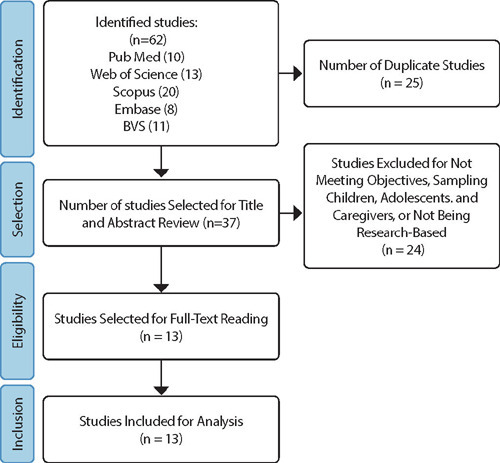
-
ARTÍCULO ORIGINAL30/08/2024
Risk of smoking cessation treatment dropout: a cohort to help (re)think care
Revista Brasileira de Enfermagem. 2024;77:e20230537
Resumen
ARTÍCULO ORIGINALRisk of smoking cessation treatment dropout: a cohort to help (re)think care
Revista Brasileira de Enfermagem. 2024;77:e20230537
DOI 10.1590/0034-7167-2023-0537
Visualizações0Ver maisABSTRACT
Objectives:
to evaluate the relative risk of smoking cessation treatment dropout during its intensive phase.
Methods:
a retrospective and quantitative cohort study was developed from the electronic medical records of individuals who started smoking cessation treatment between 2015 and 2019 at a specialty clinic in a city in the interior of São Paulo, Brazil. The relative risk of dropping out of treatment was calculated using the Poisson regression model.
Results:
it was observed that out of the 396 (100.0%) individuals who started the treatment, 109 (27.5%) abandoned it before the end of the intensive phase. For each one-year increase in age, the risk of dropping out of smoking cessation treatment decreased by an average of 2%.
Conclusions:
the risk of dropping out of smoking cessation treatment is higher among younger individuals. It is necessary to rethink the care offered to younger adults to promote the continuity of treatment.

-
30/08/2024
Fatores determinantes para à hesitação vacinal contra a COVID-19 em brasileiros: estudo utilizando modelagem de equações estruturais
Revista Brasileira de Enfermagem. 2024;77:e20240112
Resumen
Fatores determinantes para à hesitação vacinal contra a COVID-19 em brasileiros: estudo utilizando modelagem de equações estruturais
Revista Brasileira de Enfermagem. 2024;77:e20240112
DOI 10.1590/0034-7167-2024-0112
Visualizações0Ver maisRESUMEN
Objetivos:
investigar los factores que influyen en la vacilación ante la vacuna contra la COVID-19 entre los brasileños.
Métodos:
esta investigación empleó un enfoque observacional y analítico, utilizando una encuesta en línea. La recolección de datos se llevó a cabo en 2020 y el análisis de los datos se realizó utilizando el modelado de ecuaciones estructurales.
Resultados:
la prevalencia de la vacilación ante la vacuna fue del 27,5% (1182 individuos). Existe una correlación negativa entre la creencia en teorías de conspiración y la influencia social. Entre las diversas creencias asociadas con las intenciones de vacunación, solo las creencias en conspiraciones mostraron un valor predictivo significativo. Así, los resultados sugieren que las creencias personales impactan significativamente la vacilación ante la vacunación y también indican que la confianza en los órganos gubernamentales está inversamente relacionada con la vacilación.
Conclusiones:
la vacilación ante la vacuna emerge como un fenómeno multifacético influenciado por una amplia gama de factores, incluyendo las creencias personales, la confianza en los órganos gubernamentales y los sistemas de salud.
-
ARTÍCULO ORIGINAL30/08/2024
Factors associated with university students’ knowledge about HIV and pre- and post-exposure prophylaxis
Revista Brasileira de Enfermagem. 2024;77:e20240092
Resumen
ARTÍCULO ORIGINALFactors associated with university students’ knowledge about HIV and pre- and post-exposure prophylaxis
Revista Brasileira de Enfermagem. 2024;77:e20240092
DOI 10.1590/0034-7167-2024-0092
Visualizações0Ver maisABSTRACT
Objectives:
to analyze the factors associated with university students’ knowledge about HIV and pre- and post-exposure prophylaxis.
Methods:
a cross-sectional study was conducted with 503 university students from a southern state in Brazil; data were collected using a characterization tool and a questionnaire containing 16 statements about the topic; descriptive measures and Poisson regression models with robust variance were used for analysis.
Results:
the prevalence of adequate knowledge (i.e., scoring more than 12 correct answers) was 27.83%; students older than 24 years, enrolled in health-related courses, who had not engaged in sexual relations in the last quarter, with a history of rapid HIV testing, and who knew or had heard about the prophylaxes showed a higher likelihood of scoring more than 12 correct answers.
Conclusions:
generally, the knowledge of young people about HIV and its prophylaxes was found to be inadequate and influenced by sociodemographic, educational, and behavioral factors.
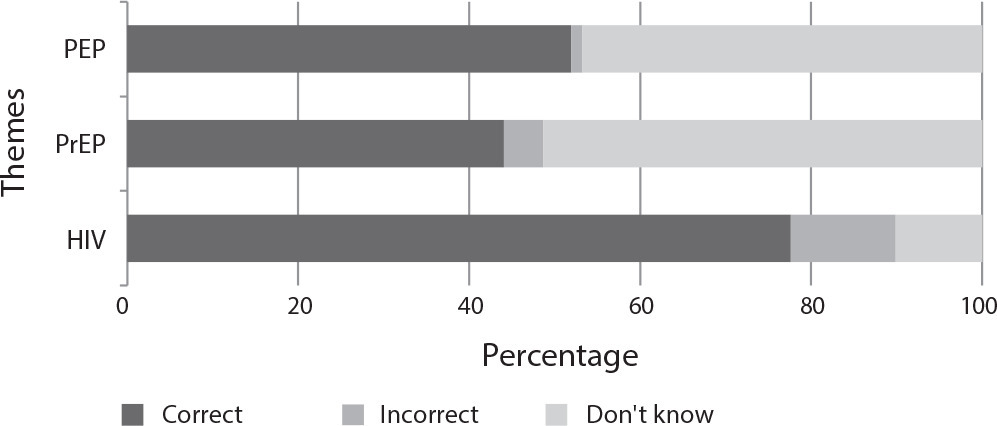
-
ARTÍCULO ORIGINAL09/04/2020
Factors associated with the discontinuance of outpatient follow-up in neonatal units
Revista Brasileira de Enfermagem. 2020;73(3):e20180793
Resumen
ARTÍCULO ORIGINALFactors associated with the discontinuance of outpatient follow-up in neonatal units
Revista Brasileira de Enfermagem. 2020;73(3):e20180793
DOI 10.1590/0034-7167-2018-0793
Visualizações1Ver maisABSTRACT
Objectives:
to identify predisposing and enabling factors as well as the health needs associated with the discontinuance of outpatient follow-up of newborns who were hospitalized at neonatal intensive care unit.
Methods:
cross-sectional study, using the behavioral model of health services use. The study was composed of 358 mothers and newborns referred to the outpatient follow-up after discharge. Characterization, perception of social support, postnatal depression, and attendance to appointments data were collected, analyzed by the R software (3.3.1).
Results:
outpatient follow-up was discontinued by 31.28% of children in the first year after discharge. In multiple regression analysis, the chance of discontinuance was higher for newborns who used mechanical ventilation (OR = 1.68; 95%CI 1.04-2.72) and depended on technology (OR = 3.54; 95%CI 1.32-9.5).
Conclusions:
predisposing factors were associated with the discontinuance of follow-up; enabling factors and health needs did not present a significant association. Children with more complex health conditions require additional support to participate in follow-up programs, thus ensuring the continuity of care.

-
ERRATUM26/02/2024
ERRATUM
Revista Brasileira de Enfermagem. 2024;77(1):e20160061
Resumen
ERRATUMERRATUM
Revista Brasileira de Enfermagem. 2024;77(1):e20160061
DOI 10.1590/0034-7167.20247701e03
Visualizações2In the article “Nurses in the labor market: professional insertion, competencies and skills”, with DOI number: , published in Revista Brasileira de Enfermagem, 2017;70(6):1220-6, on page 1225:Include before REFERENCES:[…]Ver mais -
ARTÍCULO DE REVISIÓN08/12/2024
Interventions for Strengthening General Self-Efficacy Beliefs in College Students: An Integrative Review
Revista Brasileira de Enfermagem. 2024;77(1):e20230192
Resumen
ARTÍCULO DE REVISIÓNInterventions for Strengthening General Self-Efficacy Beliefs in College Students: An Integrative Review
Revista Brasileira de Enfermagem. 2024;77(1):e20230192
DOI 10.1590/0034-7167-2023-0192
Visualizações0Ver maisABSTRACT
Objective:
To assess the evidence regarding the effectiveness of interventions aimed at strengthening self-efficacy beliefs in college students.
Methods:
Integrative Review conducted on the Lilacs, PubMed, CinahL, Cochrane Collaboration Databases, Scopus, and PsycInfo databases. The methodological quality of the studies was assessed using tools proposed by the Joanna Briggs Institute, and the results were analyzed descriptively.
Results:
Out of the 10 selected studies, six demonstrated that interventions aimed at strengthening self-efficacy were effective (Levels of Evidence II and III), and four revealed contrary results (Levels of Evidence I and II). Programs aimed at enhancing self-efficacy should include content on positive mental health, psychoeducation strategies, cover a period of eight to twelve weeks, and consider the completion of homework assignments.
Conclusion:
The synthesis of evidence pointed to pathways for building an effective self-efficacy strengthening program to be implemented in universities.
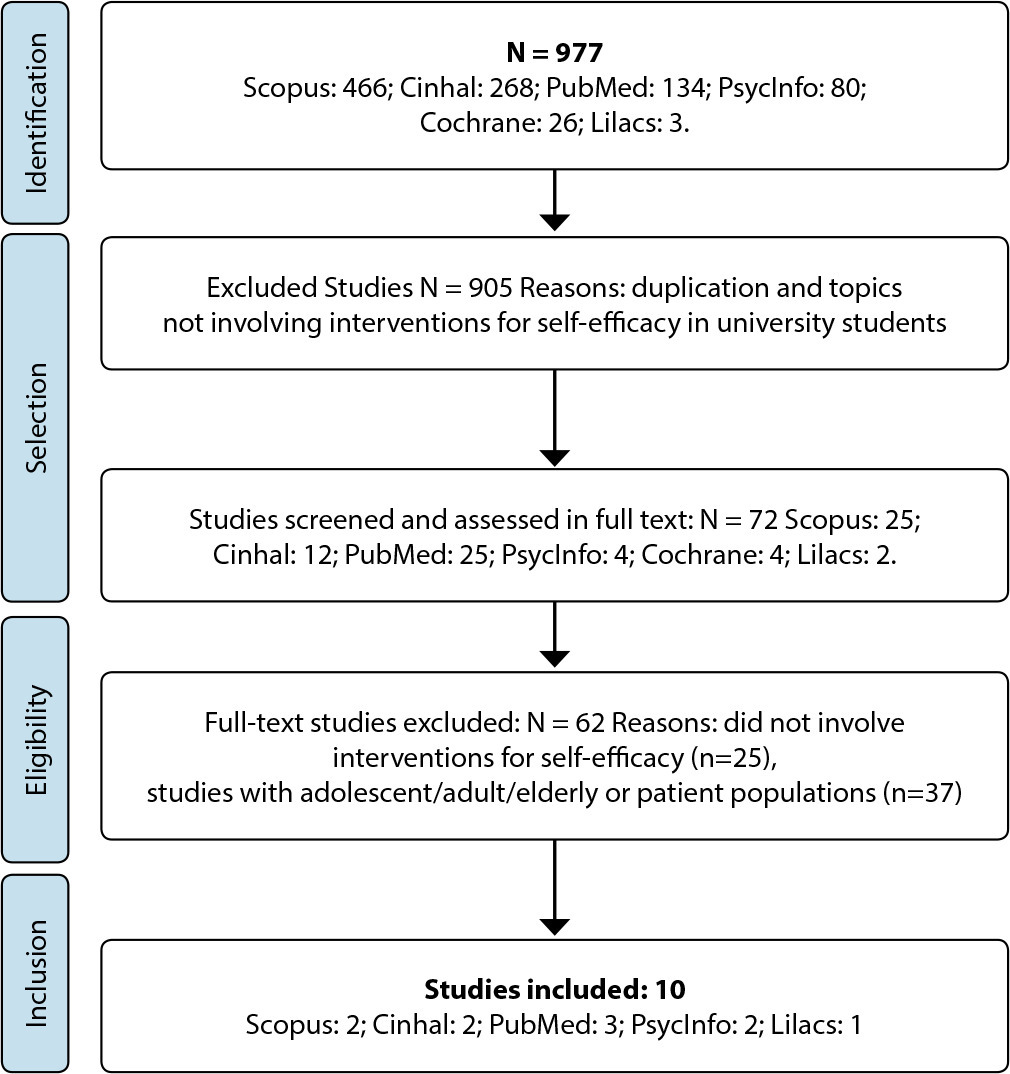
-
ARTÍCULO ORIGINAL13/05/2024
Generalized Resistance Deficits in inmates with hypertension: missing resources that limit health
Revista Brasileira de Enfermagem. 2024;77(2):e20230246
Resumen
ARTÍCULO ORIGINALGeneralized Resistance Deficits in inmates with hypertension: missing resources that limit health
Revista Brasileira de Enfermagem. 2024;77(2):e20230246
DOI 10.1590/0034-7167-2023-0246
Visualizações0Ver maisABSTRACT
Objective:
to understand the Generalized Resistance Deficits of people deprived of liberty with hypertension in a Brazilian prison unit.
Method:
qualitative research, anchored in Salutogenesis, carried out with 38 people with hypertension from a Brazilian prison unit, from February to July 2022, with a semi-structured interview with open-ended questions, whose analysis was thematic, explaining the limitations to health in prison.
Results:
13 Generalized Resistance Deficits were reported, mostly related to the prison environment and, to a lesser extent, to the social group and the individual, respectively. Living in prison for people with hypertension implies living with a high number of Generalized Resistance Deficits, accentuating the movement towards the disease pole.
Final considerations:
knowing Generalized Resistance Deficits allows directing health promotion to support the use of available Generalized Resistance Resources and contributes to the expansion of intersectoral policies.
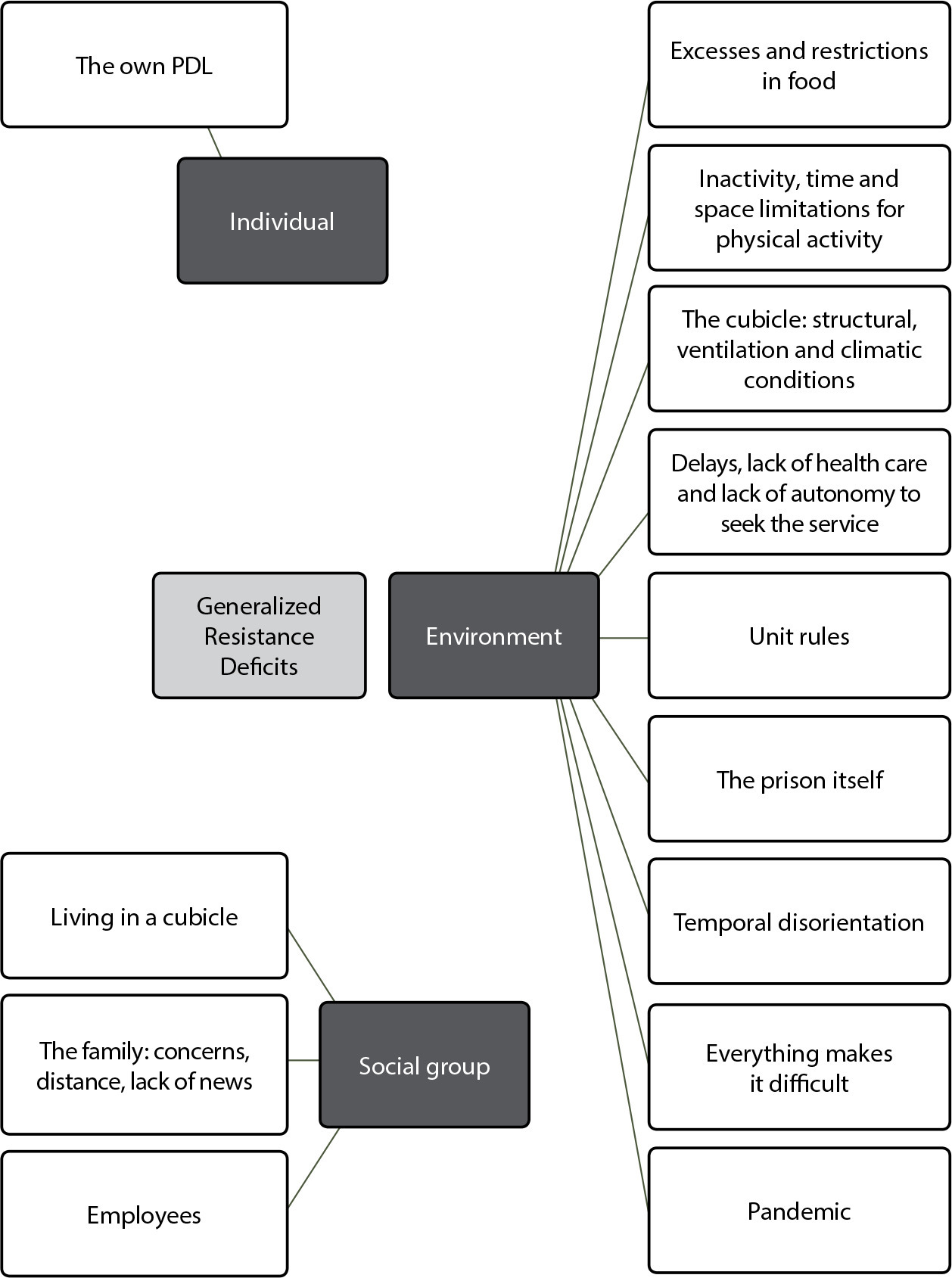
-
ERRATUM14/06/2024
ERRATUM
Revista Brasileira de Enfermagem. 2024;77(2):e2024n2e05
Resumen
ERRATUMERRATUM
Revista Brasileira de Enfermagem. 2024;77(2):e2024n2e05
DOI 10.1590/0034-7167.20247702e05
Visualizações2In the article “Educational technologies used to promote self-care for people with diabetes mellitus: integrative review”, with DOI number: , published in Revista Brasileira de Enfermagem, 2023;76(Suppl 4):e20230049, in the title:Where it read:[…]Ver mais -
ERRATUM14/06/2024
ERRATUM
Revista Brasileira de Enfermagem. 2024;77(2):e2024n2e06
Resumen
ERRATUMERRATUM
Revista Brasileira de Enfermagem. 2024;77(2):e2024n2e06
DOI 10.1590/0034-7167.20247702e06
Visualizações2In the article “Is there scientific relevance to the plot of films and documentaries about eating disorders?”, with DOI number: , published in Revista Brasileira de Enfermagem, 2024;77(1):e20220547, page 7:Where it read:[…]Ver mais -
ARTÍCULO DE REVISIÓN29/07/2024
Profile of scientific production on nursing technology construction, validity and application: a bibliometric study
Revista Brasileira de Enfermagem. 2024;77(3):e20230452
Resumen
ARTÍCULO DE REVISIÓNProfile of scientific production on nursing technology construction, validity and application: a bibliometric study
Revista Brasileira de Enfermagem. 2024;77(3):e20230452
DOI 10.1590/0034-7167-2023-0452
Visualizações1Ver maisABSTRACT
Objective:
to analyze the profile of scientific production on nursing technology construction, validity and application.
Methods:
this is a bibliometric study, carried out in six databases, based on the Methodi Ordinatio application, arranged in nine stages. To represent the findings, the VOSviewer® software was used.
Results:
346 studies were identified, obtained from BDENF, CINAHL, EMBASE, LILACS, PubMed/MEDLINE, Scopus and Web of Science. There was a predominance of the English language, and 20% of the authors hold more than 25% of studies. Only two journals account for 25% of studies in the period studied. Twenty-six studies were selected for the InOrdinatio classification. Nursing Process (23%) stood out among the studies. The most produced technology was software (27%), and 50% of works describe construction and validity.
Conclusions:
there is an emphasis on the creation of educational technologies, especially information technology. The data demonstrates opportunities for future research in the area.

-
ARTÍCULO ORIGINAL10/01/2024
Inventory of ethical problems in mobile pre-hospital care
Revista Brasileira de Enfermagem. 2024;77:e20230539
Resumen
ARTÍCULO ORIGINALInventory of ethical problems in mobile pre-hospital care
Revista Brasileira de Enfermagem. 2024;77:e20230539
DOI 10.1590/0034-7167-2023-0539
Visualizações1Ver maisABSTRACT
Objective:
to construct and validate the content of an inventory of ethical problems experienced by nurses in mobile pre-hospital care.
Method:
a psychometric approach study, developed with the following stages: (1) instrument construction through a theoretical matrix based on deliberative bioethics, scoping review and online qualitative research; (2) content validity by judges; (3) pre-testing with Mobile Emergency Care Service nurses in various Brazilian states. For content validity analysis, the Content Validity Ratio was calculated (CVR>0.45 for judges and CVR>0.35 for the target population).
Results:
the instrument had 44 items, distributed across four dimensions.
Final considerations:
the constructed instrument presented sources of evidence of content validity, providing good psychometric measurements and constituting a useful tool for nurses’ practice in the pre-hospital setting.
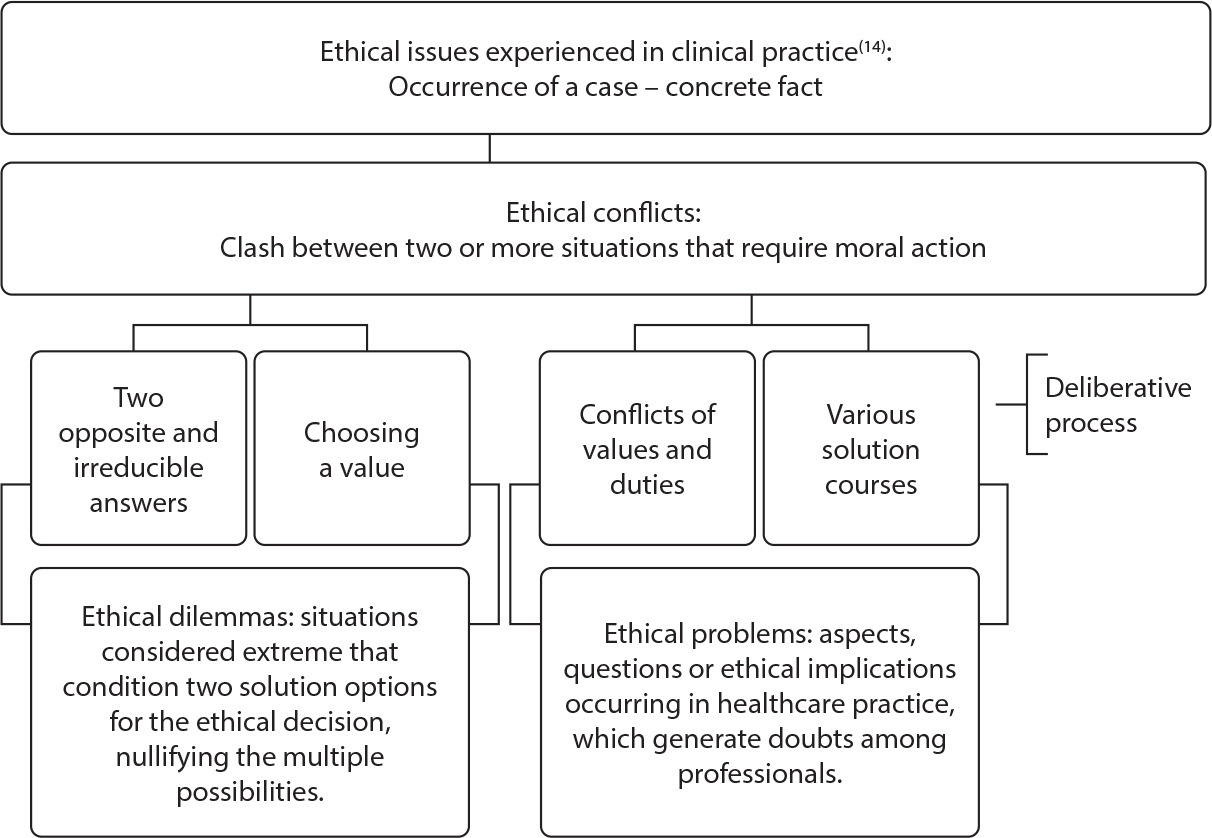
-
ARTÍCULO ORIGINAL13/07/2020
A saúde mental da enfermagem no enfrentamento da COVID-19 em um hospital universitário regional
Revista Brasileira de Enfermagem. 2020;73:e20200434
Resumen
ARTÍCULO ORIGINALA saúde mental da enfermagem no enfrentamento da COVID-19 em um hospital universitário regional
Revista Brasileira de Enfermagem. 2020;73:e20200434
DOI 10.1590/0034-7167-2020-0434
Visualizações0Ver maisRESUMO
Objetivo:
identificar a prevalência e fatores associados à ansiedade e depressão em profissionais de enfermagem que atuam no enfrentamento da COVID-19 em hospital universitário.
Métodos:
estudo observacional transversal, com questionário sociodemográfico e Escala de Medida de Ansiedade e Depressão, com 88 profissionais de enfermagem. Os dados foram analisados por meio de frequência absoluta e relativa, utilizando o software Statistical Package for the Social Sciences.
Resultados:
houve prevalência de ansiedade (48,9%) e de depressão (25%). A maioria da amostra foi composta por mulheres, com mais de 40 anos, casadas ou em união estável, de cor branca, com ensino superior ou pós-graduação, com renda superior a R$3.000,00, concursadas, com regime de trabalho de 40 horas semanais e tempo de atuação no hospital de 1 a 5 anos.
Conclusão:
deve-se considerar o impacto na saúde mental da enfermagem acarretado pela COVID-19 e intervir com estratégias de enfrentamento para minimizar o sofrimento dos profissionais.
-
22/04/2020
Thematic content analysis using ATLAS.ti software: Potentialities for researchs in health
Revista Brasileira de Enfermagem. 2020;73(3):e20190250
Resumen
Thematic content analysis using ATLAS.ti software: Potentialities for researchs in health
Revista Brasileira de Enfermagem. 2020;73(3):e20190250
DOI 10.1590/0034-7167-2019-0250
Visualizações0ABSTRACT
Objective:
to describe the most important tools of ATLAS.ti Software and to associate them with the procedures of Thematic Content Analysis.
Method:
It is a theoretical reflection of the Content Analysis phases of Laurence Bardin, associating them with software tools Atlas.ti and showing its usefulness for data analysis in qualitative research.
Results:
historical contextualization and the available resources of Atlas.ti software with presentation of health research involving the phases of thematic content analysis.
Final considerations:
The Atlas.ti software assists in the accomplishment of the thematic content analysis being this promising association in health research.
Palavras-chave: Information ManagementPrimary Health CareQualitative AnalysisQualitative ResearchSoftwareVer mais -
REFLEXIÓN26/10/2020
Nursing education: challenges and perspectives in times of the COVID-19 pandemic
Revista Brasileira de Enfermagem. 2020;73:e20200683
Resumen
REFLEXIÓNNursing education: challenges and perspectives in times of the COVID-19 pandemic
Revista Brasileira de Enfermagem. 2020;73:e20200683
DOI 10.1590/0034-7167-2020-0683
Visualizações0Ver maisABSTRACT
Objective:
To discuss the challenges and perspectives of nursing education in times of the COVID-19 pandemic.
Methods:
Reflection study, with theoretical approach based on national and international publications, allied to the experience of researchers in the area of nursing education.
Results:
Four sections are identified: Nursing education: current affairs and perspectives; Education and technologies in time of pandemic: acceleration, alteration and paralysis; Difference between emergency, intentional and remote teaching; the return to the “new normality”: new structuring axes and legal norms.
Final considerations:
The conclusion is that longstanding challenges have emerged with the pandemic, and the processes of acceleration, change and paralysis have marked education in these times. Moreover, epidemiological, technological and psychological aspects should be more valued in the return to activities.
-
ARTÍCULO ORIGINAL13/11/2020
Determinantes sociais da saúde e infecção por COVID-19 no Brasil: uma análise da epidemia
Revista Brasileira de Enfermagem. 2020;73:e20200673
Resumen
ARTÍCULO ORIGINALDeterminantes sociais da saúde e infecção por COVID-19 no Brasil: uma análise da epidemia
Revista Brasileira de Enfermagem. 2020;73:e20200673
DOI 10.1590/0034-7167-2020-0673
Visualizações0RESUMO
Objetivo:
Analisar a influência de fatores socioeconômicos, demográficos, epidemiológicos e da estrutura do sistema de saúde na evolução da pandemia da COVID-19 no Brasil.
Métodos:
Estudo ecológico com variáveis extraídas de bancos de dados, tendo a incidência e mortalidade por COVID 19 até 23 de agosto de 2020, nos estados brasileiros, como variáveis-resposta. A magnitude das associações foi estimada usando o coeficiente de correlação de Spearman e análise de regressão múltipla.
Resultados:
Nos estados brasileiros, 59,8% da variação da incidência de COVID-19 foi justificada pela desigualdade de renda, maior adensamento domiciliar e maior letalidade. No caso da mortalidade, essas mesmas variáveis explicaram 57,9% das variações encontradas nas Unidades Federativas do país.
Conclusão:
Nossos resultados indicam que fatores socioeconômicos influenciaram a evolução e impacto da COVID-19 no Brasil. Dessa forma, sugerimos ações abrangentes a fim de garantir condições econômicas e o fortalecimento das redes de saúde para populações com vulnerabilidade socioeconômica.
Palavras-chave: Determinantes Sociais da SaúdeEpidemiasEpidemiologiaInfecçõesInfecções por CoronavirusVer mais -
ARTÍCULO ORIGINAL27/02/2020
Prevalência de sintomas e qualidade de vida de pacientes com câncer
Revista Brasileira de Enfermagem. 2020;73(2):e20180287
Resumen
ARTÍCULO ORIGINALPrevalência de sintomas e qualidade de vida de pacientes com câncer
Revista Brasileira de Enfermagem. 2020;73(2):e20180287
DOI 10.1590/0034-7167-2018-0287
Visualizações0RESUMO
Objetivos:
analisar a prevalência de sintomas e sua relação com a qualidade de vida de pacientes com câncer.
Métodos:
estudo transversal com amostra de 107 pacientes avaliados por meio de formulário sociodemográfico, escala hospitalar de ansiedade e depressão (HADS) e escala de qualidade de vida (EORTC-QLQ-C30). O teste de correlação de Pearson foi utilizado para avaliar a relação entre sintomas e a qualidade de vida.
Resultados:
predomínio de pacientes do sexo feminino (56,1%), idade média de 55 anos e escolaridade de 10 anos. Verificou-se fadiga (76,6%), insônia (47,7%), dor (42,1%), perda de apetite (37,4%), ansiedade (31,8%) e depressão (21,5%). Os sintomas de ansiedade e depressão apresentaram correlação negativa com qualidade de vida e correlação positiva com sintomas físicos.
Conclusões:
fadiga, insônia, dor e perda de apetite foram os sintomas mais frequentes e mais intensos. Sintomas de ansiedade e depressão mostraram correlação negativa com qualidade de vida e positiva com sintomas físicos.
Palavras-chave: Avaliação de SintomasEnfermagem OncológicaNeoplasiasQualidade de VidaSinais e SintomasVer mais -
ARTÍCULO ORIGINAL10/08/2020
A Escala de Braden na avaliação do risco para lesão por pressão
Revista Brasileira de Enfermagem. 2020;73(6):e20190413
Resumen
ARTÍCULO ORIGINALA Escala de Braden na avaliação do risco para lesão por pressão
Revista Brasileira de Enfermagem. 2020;73(6):e20190413
DOI 10.1590/0034-7167-2019-0413
Visualizações0RESUMO
Objetivo:
Analisar a aplicabilidade da Escala de Braden a indivíduos internados em Unidade de Terapia Intensiva (UTI) com o diagnóstico de enfermagem “mobilidade do leito prejudicada”, em seu potencial de predição do desenvolvimento de lesão por pressão (LPP).
Métodos:
Estudo transversal, quantitativo, que avaliou, com a Escala de Braden, pacientes internados em uma UTI entre novembro de 2016 e fevereiro de 2017.
Resultados:
A prevalência de lesão por pressão foi 35,8% (24/67), no sexo masculino (58,3%; 14/24), com diagnóstico de acidente vascular encefálico (AVE) isquêmico (51,9%; 12/27) e com acidente vascular encefálico hemorrágico (7,4%; 2/27). Dentre os pacientes classificados com risco muito alto de desenvolver lesão por pressão, 83,3% (20/53) a desenvolveram e 76,7% (33/53) não a desenvolveram.
Conclusão:
O desempenho da Escala de Braden apresentou equilíbrio entre sensibilidade e especificidade, mostrando-se melhor instrumento preditivo de risco nessa clientela.
Palavras-chave: Assistência Integral à SaúdeAvaliação em EnfermagemCuidados CríticosCuidados de EnfermagemDiagnósticos de EnfermagemVer mais -
ARTÍCULO DE REVISIÓN24/03/2021
Strategies of active learning methodologies in nursing education: an integrative literature review
Revista Brasileira de Enfermagem. 2021;74(1):e20200130
Resumen
ARTÍCULO DE REVISIÓNStrategies of active learning methodologies in nursing education: an integrative literature review
Revista Brasileira de Enfermagem. 2021;74(1):e20200130
DOI 10.1590/0034-7167-2020-0130
Visualizações0Ver maisABSTRACT
Objectives:
to analyze the scientific evidence on the strategies of active learning methodologies used in the training of nurses, as well as their contributions and obstacles in training.
Methods:
integrative literature review conducted with 33 selected articles in the Medical Literature Analysis and Retrieval System Online, Latin American and Caribbean Literature in Health Sciences, Nursing Database, Scopus, Web of Science and Education Resources Information Center databases.
Results:
among the strategies, simulation, problem-based learning and flipped classroom were highlighted. The active search, the integration of theory and practice and group work were examples of contributions to the training of nurses. However, the lack of preparation of the actors and the lack of structural support contribute to the dissatisfaction of the students.
Final Considerations:
the active learning methodology places the student at the heart of the learning process, favors critical thinking and the ability to make decisions.
-
ARTÍCULO ORIGINAL16/09/2019
Validação de cartilha educativa: uma tecnologia educacional na prevenção da dengue
Revista Brasileira de Enfermagem. 2019;72(5):1318-1325
Resumen
ARTÍCULO ORIGINALValidação de cartilha educativa: uma tecnologia educacional na prevenção da dengue
Revista Brasileira de Enfermagem. 2019;72(5):1318-1325
DOI 10.1590/0034-7167-2018-0771
Visualizações1Ver maisRESUMO
Objetivo:
validar uma cartilha sobre prevenção da dengue, a fim de torná-la uma tecnologia educacional para ser utilizada com a população.
Método:
estudo metodológico, realizado com dois grupos de juízes especialistas da Saúde e de outras áreas. Para a análise dos dados, foi realizado o cálculo de Índice de Validade de Conteúdo.
Resultados:
a cartilha, em geral, foi considerada válida pelos juízes especialistas, visto que obteve um IVC global de 70%. Entretanto, passou por uma reelaboração textual e estética. As alterações recaíram sobre a substituição de expressões, frases, acréscimo de informações e adequação de linguagem. As ilustrações foram refeitas, acrescentando clareza, expressividade, movimento, interação e contextualização.
Conclusão:
a cartilha é válida a ser utilizada para a população, com o objetivo de informar, de maneira lúdica, as formas de prevenção e combate ao mosquito transmissor da dengue.
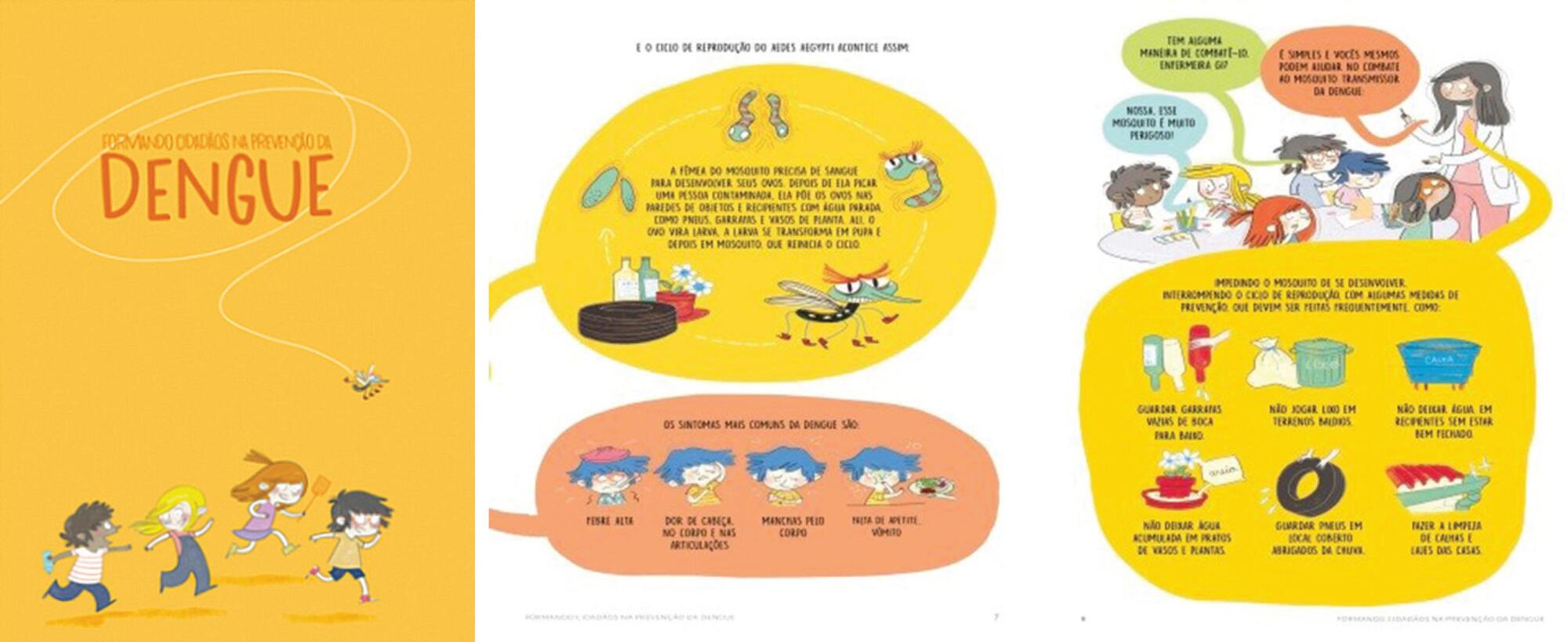
Búsqueda
Buscar en:
Nuvem de Tags
Adolescente (85) Atenção Primária à Saúde (239) COVID-19 (91) Criança (91) Cuidados de Enfermagem (269) Educação em Enfermagem (151) Educação em Saúde (139) Enfermagem (930) Enfermagem Pediátrica (86) Estudantes de Enfermagem (77) Estudos de Validação (131) Família (87) Idoso (208) Promoção da Saúde (99) Qualidade de Vida (104) Saúde do Trabalhador (86) Saúde Mental (145) Saúde Pública (82) Segurança do Paciente (150) Tecnologia Educacional (100)



